文章信息
- 李委涛, 郑玉龙, 冯玉龙
- LI Weitao, ZHENG Yulong, FENG Yulong
- 飞机草入侵种群与原产地种群生长性状的差异
- Differences in growth traits between Chromolaena odorata plants from invasive and native populations
- 生态学报, 2014, 34(23): 6890-6897
- Acta Ecologica Sinica, 2014, 34(23): 6890-6897
- http://dx.doi.org/10.5846/stxb201312152959
-
文章历史
- 收稿日期:2013-12-18
- 修订日期:2014-06-19
2. 中国科学院大学, 北京 100049;
3. 沈阳农业大学, 沈阳 110866
2. University of Chinese Academy of Sciences, Beijing 100049, China;
3. Shenyang Agricultural University, Shenyang 110866, China
为揭示外来植物成功入侵的机制,各国科学家开展了大量研究,提出很多理论或假说,如增强竞争能力的进化(Evolution of Increased Competitive Ability,EICA)假说[1, 2]、氮分配的进化假说[3, 4]、天敌逃逸假说[5, 6]、新武器假说[2, 7, 8]。EICA假说认为,脱离原产地的天敌后,进化使外来物种失去对天敌的抗性,并把原来用于维持抗性的资源用于生长、生殖等过程,从而提高入侵能力[1],有很多研究支持该假说[9, 10, 11, 12]。例如,Barney等[13]发现,与原产地种群相比,北艾(Artemisia vulgaris)入侵种群具有更多的分枝,更大的根系和更高的生物量,从而具有更强的竞争力。但不支持EICA假说的证据也时有报道。例如,在同质种植园中,葱芥(Alliaria petiolata)原产地种群的株高和果实产量高于入侵种群[14],豚草(Ambrosia artemisiifolia)入侵种群的防御力并未降低,植株也小于原产地种群[15]。入侵地种群可能只源自原产地的少数个体或种群,在同质种植园中笼统地比较入侵地种群与原产地种群生物量、分枝数、株高、繁殖能力等数量性状的差异不能排除奠基者效应(由原产地少数个体建立并发展起来的入侵种遗传多样性降低,且与其少数祖先相近)的影响,难以得出入侵植物是否发生引入后进化的确切结论[2]。为排除奠基者效应的可能影响,我们应该比较研究入侵种群与其祖先种群的差异。
飞机草(Chromolaena odorata (L.) King & Robinson; Asteraceae)原产于中、南美洲,现已扩散至非洲、亚洲、大洋洲、西太平洋群岛的大部分热带及亚热带地区[16, 17],是世界上危害最严重的100 种有害外来入侵物种之一[18]。1934年在我国云南南部首次发现飞机草,目前已扩散到台湾、广东、香港、澳门、海南、广西、云南和贵州,是我国首批公布的恶性入侵杂草之一。在原产地飞机草有240 种节肢动物天敌,其中很多对飞机草具有寄主专一性[19]。而在入侵地,据我们的野外调查仅有蜗牛、蚜虫等少数天敌取食飞机草,且危害程度非常低。Ye 等[20]利用简单序列重复区间扩增多态性(ISSR,Inter-Simple Sequence Repeat)分子标记研究发现,入侵中国的飞机草的居群内遗传多样性很低,居群间遗传分化程度也很低,总的遗传多样性(HT)仅为0.0406,Shannon信息指数 也仅为0.0623,推测飞机草在入侵过程中存在着严重的奠基者效应。余香琴等[21]通过对叶绿体DNA片段和核基因内转录间隔区序列 (ITS,internal transcribed spacers) 测序以及微卫星DNA分析发现,来自亚洲 10 个国家的 29 个飞机草居群均为一种单倍型,遗传多样性很低,可能均来自原产地的特立尼达和佛罗里达。Paterson等[22]也发现,入侵非洲西部和亚洲的飞机草属同一种生态型,认为这一生态型的原始种源很可能来自特立尼达和佛罗里达。为揭示引入后进化对飞机草成功入侵的贡献,本研究在同质种植园中,比较研究了飞机草10 个入侵种群和12 个原产地种群及其原产地可能的祖先种群的生长差异,以期更好地验证EICA假说。
1 材料和方法 1.1 实验地概况同质种植园设在云南省勐腊县勐仑镇中国科学院西双版纳热带植物园内,该园位于21°56′N,101°15′E,海拔约580 m,属北热带西南季风气候,一年中有明显的干季(11—4月)和雨季(5—10月)之分,平均气温21.7℃,平均相对湿度86%,平均降雨量1500—1600 mm(其中雨季占83% —87%,干季占13% —17%)[23]。
1.2 实验材料2009年3—6月,在飞机草原产地(中美洲)和入侵地(亚洲)采集各种群的种子(表 1),在每个地点(种群)随机选10 株采种子,任意两株之间至少间隔20 m,每株的种子(家系)分别保存。2010年6月,将各种群的种子在苗床上育苗,8月将大小一致(约10 cm)的幼苗移栽到同质种植园中生长,作为种质圃。
| 国家/区域Country / Region | 纬度 Latitude | 经度 Longitude | 海拔Elevation / m |
| 入侵地种群Invasive populations | |||
| 泰国中部Central Thailand | 14°25′N | 101°23′E | 739 |
| 云南景东Yunnan JingDong | 24 °17′N | 100 °50′E | 1263 |
| 云南勐仑Yunnan MengLun | 21°56′N | 101°15′E | 544 |
| 马来西亚Malaysia | 2°22′N | 102°21′E | 50 |
| 菲律宾Philippines | 8 ° 10′N | 124 °10′E | 107 |
| 斯里兰卡Sri Lanka | 7°11′N | 80°25′E | 451 |
| 云南思茅Yunnan SiMao | 22°46′N | 100°56′E | 1380 |
| 海南三亚Hainan SanYa | 18 °19′N | 109 °12′E | 23 |
| 老挝万象Lao Vientiane | 17°58′N | 102°37′E | 170 |
| 越南南部Southern Vietnam | 11°20′N | 107°24′E | 125 |
| 原产地种群Native populations | |||
| 佛罗里达Florida | 26°08′N | 80°06′W | 1—5 |
| 墨西哥Mexico | 23°40′N | 99°11′W | 600 |
| 墨西哥Mexico | 16°44′N | 93°09′W | 640 |
| 古巴Cuba | 22°45′N | 82°50′W | 565 |
| 佛罗里达Florida | 25°52′N | 80°29′W | 1—5 |
| 佛罗里达Florida | 27°06′N | 80°15′W | 1—5 |
| 佛罗里达Florida | 25°38′N | 80°20′W | 1—5 |
| 墨西哥Mexico | 18°51′N | 103°37′W | 950 |
| 波多黎各Puerto Rico | 18°12′N | 67°06′W | 103 |
| 波多黎各Puerto Rico | 18°12′N | 67°06′W | 103 |
| 特立尼达Felicity,Trinidad & Tobago | 10°31′N | 61°25′W | 10 |
| 特立尼达Mamoral,Trinidad & Tobago | 10°27′N | 61°17′W | 63 |
2012年12月中旬,在地表10cm处割掉同质种植园中生长的飞机草(10 个入侵地种群和12 个原产地种群,每个种群10 个家系,共220 株)地上部全部枝叶,使其萌生幼芽。2013年3月21日,当飞机草茎桩上幼芽约5 cm高时,在每株上挑选10 个大小一致、长势良好的芽,扦插到沙床(沙 ∶ 土=1 ∶ 1),每天浇水。1个月后,幼芽上长出根,选大小一致的幼苗移栽到10 L的花盆中,每盆1 株,每个家系1 盆,每个种群10 盆,共220 盆。每22 株(盆)为一列,每列包括来自原产地和入侵地的各种群飞机草各1株,盆与盆之间的距离是50 cm,列与列之间的距离是70 cm。根据需要进行浇水(滴灌)、除草、喷药(排除天敌取食压力)、定时转盆(尽量减小位置效应的影响)。幼苗栽种后在透光率50%的遮阴网下生长1个月,之后移去遮阴网,使其在全光下生长。
栽培基质由林内去表面枯落物后的25 cm以上表土(砖红壤)和河砂按6:4(体积比)混匀而成,每盆装土 10 kg。施肥前基质养分含量为:pH值为4.91,有机质为8.72 g/kg,全N为0.80 g/kg,总P为0.21 g/kg,总K为22.39 g/kg,水解N为43.42 mg/kg,有效P为1.17 mg/kg,有效K为43.33 mg/kg (中国科学院西双版纳热带植物园生物地球化学实验室测定)。按土壤肥力的评价标准[24, 25],此基质的有机质和总N、P、K含量较高,有效N、P、K含量严重不足。
1.4 测定幼苗成活后,用刻度尺测量初始株高。为观测飞机草幼苗生长动态在产地间的差异,于2013年6、8和9月再测定3次株高(每月1日)。移栽130d后,每株选10 片成熟叶片,用LI-3000C叶面积仪(Li-Cor,Lincoln,NE,USA)测定叶面积,烘干称重,计算比叶面积;用数显游标卡尺测定植株的基径(两个垂直方向测定值的均数),统计各株5 cm以上长的分枝数。最后收获全部植株,带回实验室,在60℃烘干48 h,用电子天平(精确度0.01 g)称重。
1.5 统计分析用一元嵌套方差分析(线性混合模型)检验飞机草10 个入侵种群与全部12 个原产地种群的差异;产地为固定因子,种群嵌套在产地中做随机因子。为排除奠基者效应的影响,进一步用一元嵌套方差分析比较飞机草10 个入侵种群与6 个原产地可能的祖先种群(特立尼达和佛罗里达)各参数的差异。用Pearson相关(one-tailed)分别分析了生物量、株高、分枝数和基茎与比叶面积的相关关系。所有数据分析均用SPSS 21.0(SPSS Inc. Chicago,IL,USA)。
2 结果与12 个原产地种群相比,飞机草10 个入侵地种群株高(产地: F1,20=4.695,P=0.043; 种群: F20,216=9.422,P < 0.001)、基茎(产地: F1,20=5.454,P=0.030; 种群: F20,216=9.056,P < 0.001)、分枝数(产地: F1,20=15.848,P=0.001; 种群: F20,216=2.251,P < 0.01)、总生物量(产地: F1,20=11.355,P=0.003; 种群: F20,216=7.991,P < 0.001)和比叶面积(产地: F1,20=6.501,P=0.019; 种群: F20,216=5.039,P < 0.001)分别升高了12.0%、8.6%、12.9%、25.3%和6.8%,差异均达显著水平(图 1,图 2)。株高连续测定结果也表明,飞机草入侵种群生长速率高于原产地种群(图 3)。与可能的6 个祖先种群相比,飞机草10 个入侵种群分枝数(产地: F1,14=16.546,P=0.001; 种群: F14,158=2.095,P < 0.05)、总生物量(产地: F1,14=6.606,P=0.022; 种群: F14,158=5.832,P < 0.001)和比叶面积(产地: F1,14=11.145,P=0.019; 种群: F14,158=5.039,P < 0.001)分别升高了15.9%、18.3%和8.3%,差异均达显著水平(图 4,图 5)。
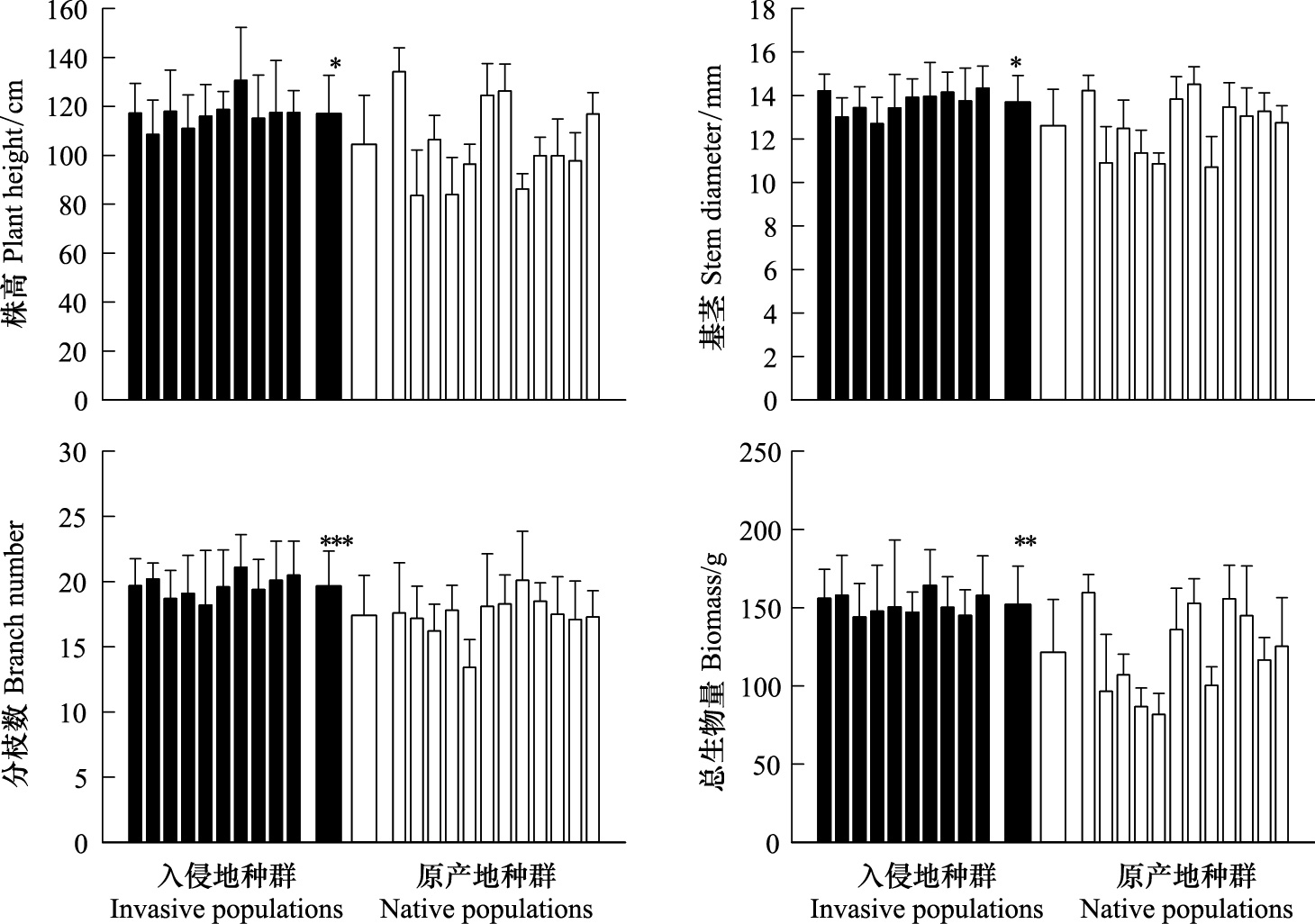
|
| 图 1 不同产地间飞机草株高、基茎、分枝数和生物量的差异 Fig. 1 Differences in plant height,stem diameter,branch number,and total biomass between Chromolaena odorata plants from invasive and native populations 窄柱表示每个种群的平均值+标准误(n=10);中间的两个粗柱表示入侵地和原产地种群的平均值+标准误(入侵地n=10; 原产地n=12); *、**和***分别表示产地间在P < 0.05、P < 0.01和P < 0.001水平上差异显著(一元嵌套方差分析) |
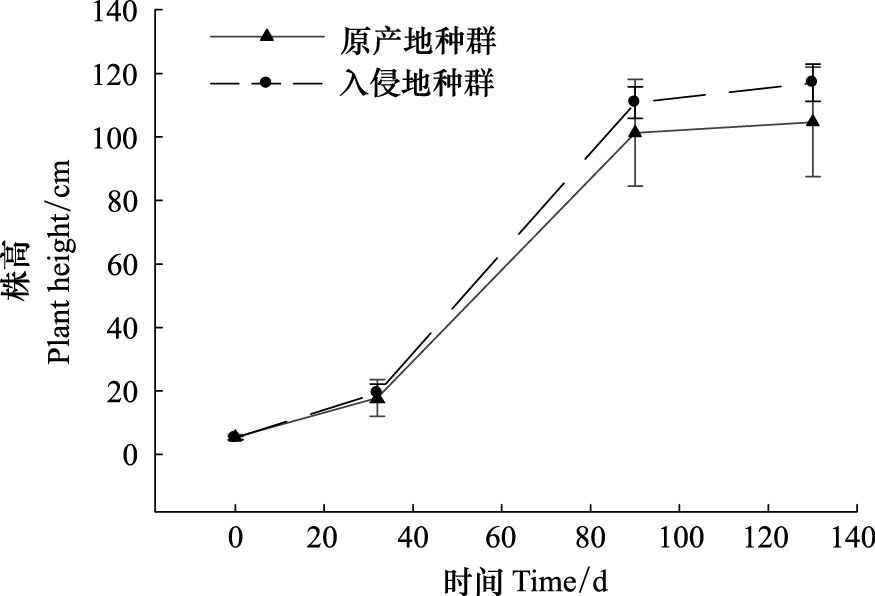
|
| 图 2 不同产地间飞机草比叶面积的差异 Fig. 2 Difference in specific leaf area between Chromolaena odorata plants from invasive and native populations 窄柱表示每个种群的平均值+标准误(n=10);中间的两个粗柱表示入侵地和原产地种群的平均值+标准误(入侵地n=10; 原产地n=12)。* 表示产地间在P < 0.05水平上差异显著(一元嵌套方差分析) |
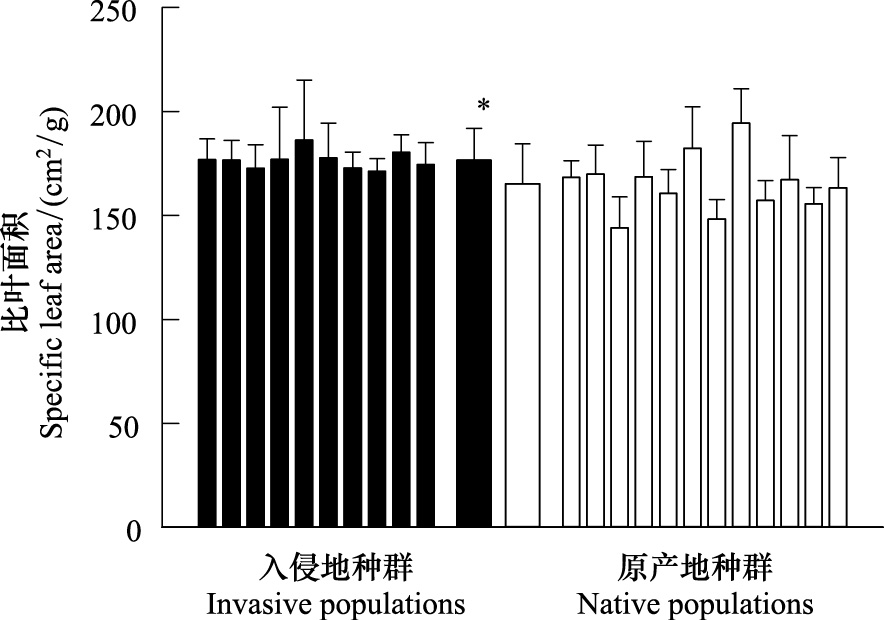
|
| 图 3 不同产地间飞机草种群株高生长速率的差异 Fig. 3 Difference in growth rate between Chromolaena odorata plants from invasive and native populations |
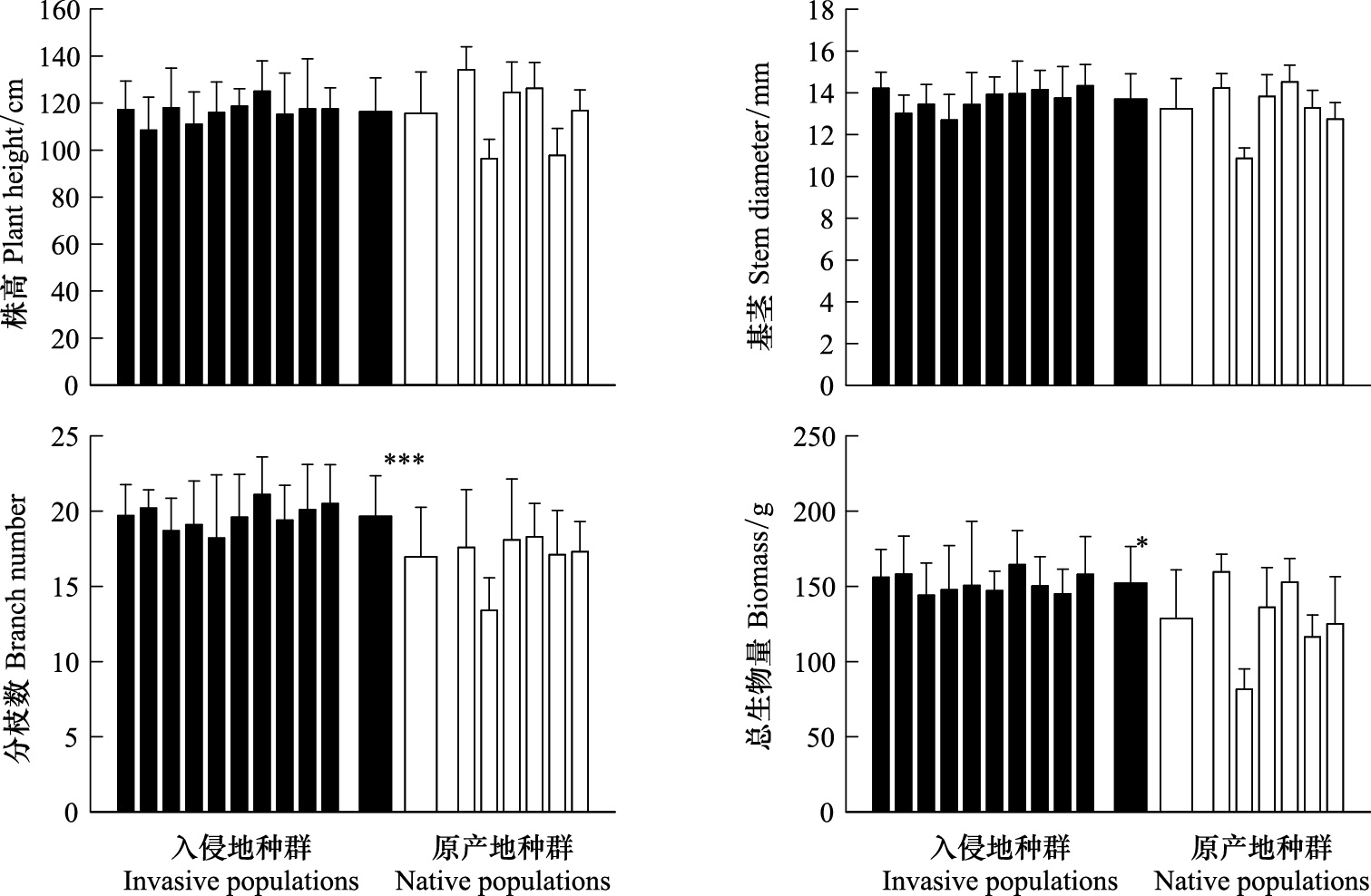
|
| 图 4 飞机草入侵地种群与原产地可能的祖先种群株高、基茎、分枝数和生物量的差异 Fig. 4 Differences in plant height,stem diameter,branch number,and total biomass between Chromolaena odorata plants from 10 invasive populations and their six putative ancestral populations 窄柱表示每个种群的平均值+标准误(n=10);中间的两个粗柱表示入侵地和原产地种群的平均值+标准误(入侵地n=10; 可能的祖先种群n=6); *和***分别表示产地间在P < 0.05和P < 0.001水平上差异显著(一元嵌套方差分析) |
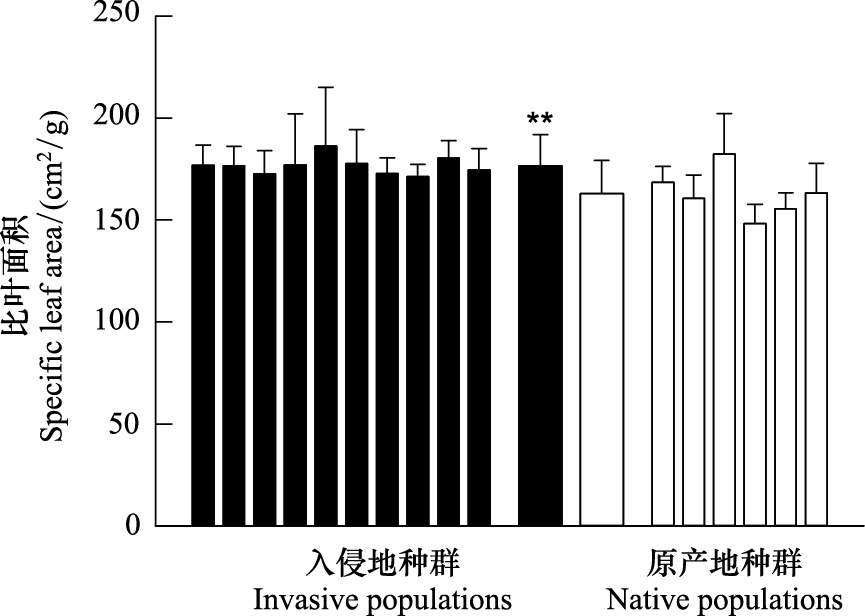
|
| 图 5 飞机草入侵地种群与原产地可能的祖先种群比叶面积的差异 Fig. 5 Difference in specific leaf area between Chromolaena odorata plants from 10 invasive populations and their six putative ancestral populations 窄柱表示每个种群的平均值+标准误(n=10);中间的两个粗柱表示入侵地和原产地种群的平均值+标准误(入侵地n=10; 可能的祖先n=6); **表示产地间在P < 0.01水平上差异显著(一元嵌套方差分析) |
飞机草22个种群的比叶面积与其生物量(r=0.186,P=0.003)和分枝数(r=0.272,P<0.001)显著正相关,但与基茎(r=-0.022,P=0.379)和株高(r=0.003,P=0.484)相关不显著(表 2)。
| 参数 Parameter | 比叶面积 Special leaf area | 生物量 Biomass | 分枝数 Branch Number | 基茎 Stem diameter | 株高 Plant height | |
| 比叶面积 Special leaf | Pearson 相关系数 (r) Pearson Coefficients (r) | 1 | 0.186 | 0.272 | -0.022 | 0.003 |
| area | 显著性(单尾) Significance (one-tailed) | 0.003 | 0.000 | 0.379 | 0.484 | |
| 样本数 sample size (N) | 218 | 218 | 218 | 218 | 218 |
和12 个原产地种群相比,飞机草入侵种群具有更高的生物量、株高、基茎、分枝数,高的生长活力有利于飞机草成功入侵,这与EICA假说一致[1]。株高和分枝数增加有利于飞机草在与本地植物竞争中获取更多的光照和空间,促进光合碳积累,并可通过荫蔽作用排挤本地植物,有利于其成功入侵[27, 28]。高的比叶面积可能是飞机草入侵种群具有高生长活力的原因之一,比叶面积与生长速率密切相关[28],本文也发现,飞机草的比叶面积与生物量和分枝数呈正相关。Feng等[29]发现,与外来非入侵植物相比,两种外来入侵植物较高的比叶面积导致其较低的叶片构建成本、较多的叶氮分配到光合系统、较高的光合氮利用效率,促进其成功入侵。
飞机草高的生长活力可能是其在入侵地对逃离专性天敌取食压力做出的进化响应,把在原产地用于天敌防御的资源投入到生长的结果。张茹等[30]发现,在两种不同的养分条件下,飞机草入侵地种群茎和叶片半纤维素含量均低于原产地种群,这可能是其对入侵地专性天敌缺乏做出的进化响应;但飞机草入侵种群总酚含量高于原产地种群,有利于飞机草防御入侵地的广谱天敌。
大量研究发现,外来植物入侵种群生长好于原产地种群[3, 4, 9, 31],但很少有研究比较入侵种群与其原产地可能的祖先种群间的差异[32, 33],不能排除奠基者效应的影响[2, 3]。假如入侵种群只来源于原产地的一个或少数种群,而这个(些)种群恰好竞争能力较强,通过比较多个入侵种群和多个原产地种群的差异,可能会发现支持EICA假说的证据;反之,这个(些)祖先种群竞争能力较弱,通过笼统比较入侵种群和原产地种群的差异,可能会发现不利于EICA假说的证据。这很有可能就是种由奠基者效应引起的入侵植物产地间的差异,而不是与引入后的适应进化的结果无关。Qin等[2]认为,同质园种植实验排除了表型可塑性对入侵植物产地间比较结果的影响,但并不能排除奠基者效应的影响,为确定飞机草入侵种群与原产地种群间生物地学上的差异是否是引入后进化的结果,需比较飞机草入侵种群与其原产地祖先种群间的差异。本研究表明,与来自佛罗里达和特立尼达的6 个可能的祖先种群相比,飞机草入侵种群的总生物量等仍然高于原产地种群,即排除奠基者效应的可能影响后,飞机草入侵种群生长仍好于原产地种群,进一步证明入侵地飞机草高的生长速率很可能是引入后适应进化的结果。
本研究仅在一种养分条件下比较了飞机草原产地和入侵地种群间生长性状的差异,结论有一定的局限性,需要在更多的(养分)条件下比较飞机草入侵种群与其原产地祖先种群的差异。Liao等[34]发现,实验条件影响同质种植环境下入侵植物产地间差异的比较结果,并认为这与入侵植物对入侵地非生物环境适应进化导致的生物量分配变化有关。
致谢: 感谢类延宝和廖志勇博士在试验中给予的帮助。| [1] | Blossey B, Nötzold R. Evolution of increased competitive ability in invasive non-indigenous plants: a hypothesis. The Journal of Ecology, 1995, 83(5): 887-889. |
| [2] | Qin R M, Zheng Y L, Valiente-Banuet A, Callaway R M, Barclay G F, Pereyra C S, Feng Y L. The evolution of increased competitive ability, innate competitive advantage, and novel biochemical weapons act in concert to promote invasion by a tropical invader. New Phytologist, 2013, 197(3): 979-988. |
| [3] | Feng Y L, Lei Y B, Wang R F, Callaway R M, Valiente-Banuet A, Inderjit, Li Y P, Zheng Y L. Evolutionary tradeoffs for nitrogen allocation to photosynthesis versus cell walls in an invasive plant. Proceedings of the National Academy of Sciences of the United States of America, 2009, 106(6): 1853-1856. |
| [4] | Feng Y L, Li Y P, Wang R F, Callaway R M, Valiente-Banuet A, Inderjit. A quicker return energy-use strategy by populations of a subtropical invader in the non-native range: a potential mechanism for the evolution of increased competitive ability. Journal of Ecology, 2011, 99(5): 1116-1123. |
| [5] | Keane R M, Crawley M J. Exotic plant invasions and the enemy release hypothesis. Trends in Ecology & Evolution, 2002, 17(4): 164-170. |
| [6] | Niu Y F, Feng Y L, Xie J L, Luo F C. Noxious invasive Eupatorium adenophorum may be a moving target: implications of the finding of a native natural enemy, Dorylus orientalis. Chinese Science Bulletin, 2010, 55(33): 3743-3745. |
| [7] | Callaway R M, Aschehoug E T. Invasive plants versus their new and old neighbors: a mechanism for exotic invasion. Science, 2000, 290(5491): 521-523. |
| [8] | Callaway R M, Ridenour W M. Novel weapons: invasive success and the evolution of increased competitive ability. Frontiers in Ecology and the Environment, 2004, 2(8): 436-443. |
| [9] | Maron J L, Vila M, Bommarco R, Elmendorf S, Beardsley P. Rapid evolution of an invasive plant. Ecological Monographs, 2004, 74(2): 261-280. |
| [10] | Bossdorf O, Auge H, Lafuma L, Rogers W. E, Siemann E, Prati D. Phenotypic and genetic differentiation between native and introduced plant populations. Oecologia, 2005, 144(1): 1-11. |
| [11] | Zou J W, Rogers W E, DeWalt S J, Siemann E. The effect of Chinese tallow tree (Sapium sebiferum) ecotype on soil-plant system carbon and nitrogen processes. Oecologia, 2006, 150(2): 272-281. |
| [12] | Uesugi A, Kessler A. Herbivore exclusion drives the evolution of plant competitiveness via increased allelopathy. New Phytologist, 2013, 198(3): 916-924. |
| [13] | Barney J N, Whitlow T H, DiTommaso A. Evolution of an invasive phenotype: shift to belowground dominance and enhanced competitive ability in the introduced range. Plant Ecology, 2009, 202(2): 275-84. |
| [14] | Bossdorf O, Prati D, Auge H, Schmid B. Reduced competitive ability in an invasive plant. Ecology Letters, 2004, 7(4): 346-353. |
| [15] | Genton B J, Kotanen P M, Cheptou P O, Adolphe C, Shykoff J A. Enemy release but no evolutionary loss of defence in a plant invasion: an inter-continental reciprocal transplant experiment. Oecologia, 2005, 146(3): 404-414. |
| [16] | Muniappan R, Reddy G V P, Lai P Y. Distribution and biological control of Chromolaena odorata. Invasive Plants: Ecological and Agricultural Aspects, 2005: 223-233. |
| [17] | Yu X Q, Feng Y L, Li Q M. Review of research advances and prospects of invasive Chromolaena odorata. Chinese Journal of Plant Ecology, 2010, 34(5): 591-600. |
| [18] | Lowe S, Browne M, Boudjelas S, De Pooer M. 100 of the world's worst invasive alien species: a selection from the global invasive species database. New Zealand: Invasive Species Specialist Group (ISSG) a specialist group of the Species Survival Commission (SSC) of the World Conservation Union (IUCN) Press, 2004: 6-7. |
| [19] | Muniappan R, Bamba J. Biological control of Chromolena odorata: successes and failures. Proceedings of the X International Symposium on Biological Control of Weeds. Bozeman, Montana. 2000: 81-85. |
| [20] | Ye W H, Mu H P, Cao H L, Ge X J. Genetic structure of the invasive Chromolaena odorata in China. Weed Research, 2004, 44(2): 129-135. |
| [21] | Yu X Q, He T H, Zhao J L, Li Q M. Invasion genetics of Chromolaena odorata (Asteraceae): extremely low diversity across Asia. Biological Invasions, doi:10.1007/s10530-014-0669-2. |
| [22] | Paterson I D, Zachariades C. ISSRs indicate that Chromolaena odorata invading southern Africa originates in Jamaica or Cuba. Biological Control, 2013, 66(2): 132-139. |
| [23] | Liu W J, Zhang Y P, Li H M, Liu Y H, Duan W P. Edge effect of intercepted fog water by forest canopy at a rubber plantation in Xishuangbanna, Southwest China. Acta Ecologica Sinica, 2004, 24(7): 1430-1435. |
| [24] | Wang M L, Feng Y L. Effects of soil nitrogen levels on morphology, biomass allocation and photosynthesis in Ageratina adenophora and Chromoleana odorata. Chinese Journal of Plant Ecology, 2005, 29(5): 697-705. |
| [25] | Zhang S R, Huang Y F, Li B G, Zhang F R, Hu K L. Temporal-spatial variability of soil nitrogen nutrients in Quzhou County, Hebei Province. Acta Pedologica Sinica, 2003, 40(3): 475-479. |
| [26] | Feng Y L, Wang J F, Sang W G. Biomass allocation, morphology and photosynthesis of invasive and noninvasive exotic species grown at four irradiance levels. Acta Oecologica, 2007, 31(1): 40-47. |
| [27] | Zheng Y L, Feng Y L, Liu W X, Liao Z Y. Growth, biomass allocation, morphology and photosynthesis of invasive Eupatorium adenophorum and its native congeners grown at four irradiances. Plant Ecology, 2009, 203(2): 263-271. |
| [28] | Feng Y L, Auge H, Ebeling S K. Invasive Buddleja davidii allocates more nitrogen to its photosynthetic machinery than five native woody species. Oecologia, 2007, 153(3): 501-510. |
| [29] | Feng Y L. Photosynthesis, nitrogen allocation and specific leaf area in invasive Eupatorium adenophorum and native Eupatorium japonicum grown at different irradiances. Physiologia Plantarum, 2008, 133(2): 318-326. |
| [30] | Zhang R, Liao Z Y, Li Y P, Feng Y L. Comparisons of growth and quantitative defense compounds between plants from invasive and native populations of Chromolaena odorata. Bulletin of Botanical Research, 2011, 31(6): 750-757. |
| [31] | Flory S L, Long F, Clay K. Invasive Microstegium populations consistently outperform native range populations across diverse environments. Ecology, 2011, 92(12): 2248-2257. |
| [32] | Dlugosch K M, Parker I M. Founding events in species invasions: genetic variation, adaptive evolution, and the role of multiple introductions. Molecular Ecology, 2008, 17(1): 431-449. |
| [33] | Xu C Y, Julien M H, Fatemi M, Girod C, Van Klinken R D, Gross C L, Novak S J. Phenotypic divergence during the invasion of Phyla canescens in Australia and France: evidence for selection-driven evolution. Ecology Letters, 2010, 13(1): 32-44. |
| [34] | Liao Z Y, Zhang R, Barclay G F, Feng Y L. Differences in competitive ability between plants from nonnative and native populations of a tropical invader relates to adaptive responses in abiotic and biotic environments. Plos One, 2013, 8(8): e71767 |
| [17] | 余香琴, 冯玉龙, 李巧明. 外来入侵植物飞机草的研究进展与展望. 植物生态学报, 2010, 34(5): 591-560. |
| [23] | 刘文杰, 张一平, 李红梅, 刘玉洪, 段文平. 热带人工橡胶林林冠截留雾水的边缘效应研究. 生态学报, 2004, 24(7): 1430-1435. |
| [24] | 王满莲, 冯玉龙. 紫茎泽兰和飞机草的形态、生物量分配和光合特性对氮营养的响应. 植物生态学报, 2005, 29(5): 697-705. |
| [25] | 张世熔, 黄元仿, 李保国, 张凤荣, 胡克林. 河北曲周土壤氮素养分的时空变异特征. 土壤学报, 2003, 40(3): 475-479. |
| [30] | 张茹, 廖志勇, 李杨萍, 冯玉龙. 飞机草入侵种群和原产地种群生长和数量型化学防御物质含量差异的比较研究. 植物研究, 2011, 31(6): 750-757. |
 2014, Vol. 34
2014, Vol. 34




